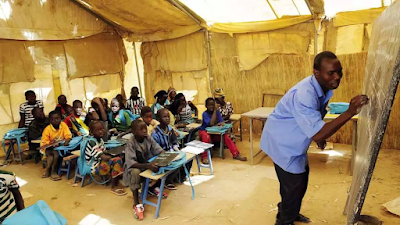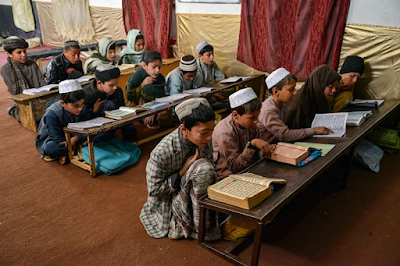South Sudan, the world's youngest nation, grapples with a lower literacy rate primarily due to prolonged conflict, economic struggles, and a lack of accessible education infrastructure. Decades of war have disrupted normal life, resulting in the displacement of populations and the destruction of schools, hindering widespread access to education. Economic challenges further strain the development of a functional education system, limiting resources for teacher training and infrastructure improvement. Cultural factors, including gender disparities and early marriage, pose additional barriers to literacy. Overcoming these obstacles requires sustained efforts in rebuilding infrastructure, fostering political stability, and prioritizing inclusive education programs, with international support playing a pivotal role in South Sudan's journey toward improved literacy rates and overall development.
Mali, situated in West Africa, faces challenges influencing its educational landscape and contributing to a lower literacy rate. The country has encountered political instability and security concerns, particularly with the presence of armed groups and periodic ethnic tensions. These factors have disrupted educational activities, displaced populations, and led to the closure of schools, limiting access to quality education. Economic difficulties, including poverty and a reliance on agriculture, further strain the education system, impeding infrastructure development and teacher training. Gender disparities persist, with cultural norms affecting girls' access to education. To address these issues and improve literacy rates, Mali requires sustained efforts in promoting stability, investing in education infrastructure, and fostering gender-inclusive policies, alongside international support to navigate these multifaceted challenges.
5. Central African Republic – 36.75%
The Central African Republic (CAR) grapples with a lower literacy rate, primarily due to a complex interplay of factors. The country has experienced prolonged political instability, marked by armed conflicts and internal strife, which have severely disrupted the education system. The presence of armed groups has led to the displacement of communities and the destruction of schools, impeding access to quality education. Economic challenges, including widespread poverty and a lack of resources, further hinder the development of a robust education infrastructure and the training of qualified teachers. The CAR also faces significant health challenges, which can impact school attendance and overall well-being. These multifaceted issues, compounded by cultural factors and gender disparities, create formidable obstacles to improving literacy rates. Addressing these challenges requires a comprehensive approach, involving political stability, economic development, and targeted efforts to enhance the accessibility and quality of education, with international support playing a crucial role in facilitating progress.
Burkina Faso, located in West Africa, contends with various challenges influencing its literacy rate. The country faces persistent economic difficulties, including high poverty rates and dependence on agriculture, which limit resources for education infrastructure and teacher training. Ongoing security concerns, marked by armed conflicts and terrorism, have led to the displacement of communities and the closure of schools, hindering access to education. Additionally, Burkina Faso confronts health challenges such as limited healthcare access, affecting overall student well-being and attendance. Cultural factors, including gender disparities, also play a role in educational disparities. Tackling these issues necessitates concerted efforts to improve economic conditions, invest in education, and address security concerns, with international collaboration playing a crucial role in supporting Burkina Faso's journey towards enhancing literacy rates and sustainable development.
Somalia faces a range of challenges contributing to its lower literacy rate. Decades of conflict, political instability, and the absence of a centralized government have disrupted the education system, resulting in the closure of schools and limiting access to quality education. Widespread poverty and a lack of economic infrastructure further constrain the development of educational resources and teacher training programs. The country's ongoing security concerns, including the presence of extremist groups, pose additional threats to the stability of educational institutions. Gender disparities persist, influenced by cultural norms and limited opportunities for girls' education. Rebuilding the education sector in Somalia requires sustained efforts in promoting peace and stability, investing in infrastructure, and fostering inclusive policies that address gender imbalances, all with international support playing a crucial role in facilitating positive change.
Afghanistan grapples with a lower literacy rate due to a complex set of challenges, prominently shaped by decades of conflict, political instability, and the presence of insurgent groups. Prolonged periods of war have severely disrupted the education system, with schools being targeted, teachers displaced, and educational resources diminished. The country's economic struggles, exacerbated by conflict, contribute to a lack of investment in education infrastructure and teacher training. Gender disparities persist, influenced by conservative cultural norms and security concerns, limiting opportunities for girls' education. Ongoing security threats, including attacks on schools, further hinder access to quality education. Rebuilding Afghanistan's education system requires sustained efforts in promoting stability, investing in infrastructure, and fostering gender-inclusive policies, with international collaboration being pivotal in supporting the country's journey toward improved literacy rates and overall development.
Benin, situated in West Africa, has made commendable strides in education, but challenges persist. While the government has shown commitment to improving the education sector, factors such as economic constraints, particularly in rural areas, still hinder widespread access to quality education. Limited infrastructure and teacher shortages pose challenges to delivering effective learning experiences. Additionally, cultural factors and traditional practices can affect girls' education. Despite these challenges, Benin has demonstrated resilience in fostering a positive learning environment. Continued efforts to invest in education infrastructure, address economic disparities, and promote gender equality will be crucial in further enhancing literacy rates and ensuring sustainable development in Benin.
Chad, located in central Africa, faces considerable challenges contributing to its lower literacy rates. The country grapples with ongoing political instability, intermittent conflicts, and economic struggles, which collectively disrupt the education system. Insufficient investment in education infrastructure, compounded by a scarcity of resources, limits access to quality schooling, particularly in remote areas. The nomadic lifestyle of certain populations and environmental factors, such as recurrent droughts, further impede regular school attendance. Gender disparities persist, influenced by cultural norms, early marriages, and limited opportunities for girls' education. To improve literacy rates in Chad, a multifaceted approach is needed, involving sustained efforts to address political stability, invest in education, and promote gender-inclusive policies, with international support playing a crucial role in fostering positive change.





















Comments
Post a Comment
Good days are on the way...